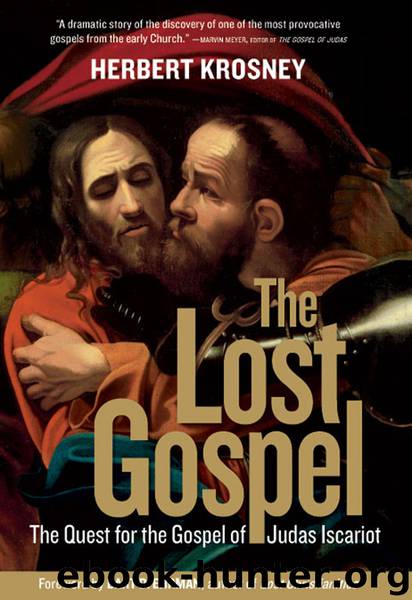The Lost Gospel by Herbert Krosney

Author:Herbert Krosney
Language: eng
Format: epub
Publisher: National Geographic Society
Published: 2006-08-19T04:00:00+00:00
Hanna and Father Gabriel arrived with a group of Coptic men, looking like a Coptic mafia. Hanna’s understanding was that the others had been brought along by Father Gabriel in order to ensure the safety of the Coptic treasures. That was a critical mistake. Though the others were stationed outside, Kraus suspected the bodyguards had guns. Hanna, of course, was accustomed to carrying a gun in Cairo, which he normally hid underneath his baggy suit, but Kraus was outraged by the presence of what he took to be armed thugs. He was unwilling to do business under such conditions.
“That would be enough to put off my father from making the acquisition,” Maryann speculated. “He wouldn’t have any part of it.”
The priest said something to Kraus in English, and Kraus replied, also in English. The words that were exchanged were beyond Hanna’s very limited understanding. Whatever was said, however, the negotiations were over before they had even begun. Father Gabriel tried to reassure Hanna that the sale was still ongoing, but Hanna was extremely upset by the aborted meeting. He would later blame the priest for killing the deal.
A second meeting was held at nine o’clock on the morning of March 27, 1984. The setting this time was the sixth floor at Hamilton Hall on the Columbia University campus, the office of a distinguished classicist, Roger Bagnall. The Kraus company was still considering the purchase and sought Bagnall’s expertise in determining more precisely what the Coptic manuscripts might contain and what their importance was. Maryann’s husband, Roland Folter, attended the meeting, and he was the one who wanted to thoroughly investigate the contents of these new Coptic documents. “The claim had been made to Kraus that these were first-century Coptic manuscripts,” Bagnall recalled, “but that was obviously nonsense, because there was no Coptic written language at that time.”
The strict new Egyptian antiquities law had just taken effect, but as Bagnall recalled, “I don’t think that anyone in the manuscript trade at that point was taking that aspect seriously.”
According to Bagnall’s records, the principals at the meeting were Folter, on behalf of the Kraus office; a Coptic priest whose name Bagnall recorded as Father Gabriel Abd el-Sayed; and himself. The priest was accompanied by two men to whom Bagnall was never properly introduced. Bagnall thought they were bodyguards, but in fact they were the owners of the property in question, Hanna and his Egyptian partner. They stayed totally silent during the entire meeting. “They were dumb appendages to the priest,” was Bagnall’s impression. “I didn’t feel threatened, and no arms were displayed or referred to. They certainly did not show any knowledge about what they had; quite the contrary. I found the whole group rather sleazy and was glad not to be doing business with them personally!” Bagnall also recalled that he was frankly doubtful whether the priest was a real priest—though he really was.
The men sat around a desk in the middle of the spacious Columbia University office. The Kraus company,
Download
This site does not store any files on its server. We only index and link to content provided by other sites. Please contact the content providers to delete copyright contents if any and email us, we'll remove relevant links or contents immediately.
| Africa | Americas |
| Arctic & Antarctica | Asia |
| Australia & Oceania | Europe |
| Middle East | Russia |
| United States | World |
| Ancient Civilizations | Military |
| Historical Study & Educational Resources |
Cecilia; Or, Memoirs of an Heiress — Volume 1 by Fanny Burney(32491)
Cecilia; Or, Memoirs of an Heiress — Volume 2 by Fanny Burney(31909)
Cecilia; Or, Memoirs of an Heiress — Volume 3 by Fanny Burney(31887)
The Secret History by Donna Tartt(18939)
Sapiens: A Brief History of Humankind by Yuval Noah Harari(14311)
Leonardo da Vinci by Walter Isaacson(13232)
The Radium Girls by Kate Moore(11967)
Sapiens by Yuval Noah Harari(5321)
How Democracies Die by Steven Levitsky & Daniel Ziblatt(5168)
The Wind in My Hair by Masih Alinejad(5056)
Homo Deus: A Brief History of Tomorrow by Yuval Noah Harari(4870)
Endurance: Shackleton's Incredible Voyage by Alfred Lansing(4715)
Man's Search for Meaning by Viktor Frankl(4495)
The Silk Roads by Peter Frankopan(4487)
Millionaire: The Philanderer, Gambler, and Duelist Who Invented Modern Finance by Janet Gleeson(4417)
The Rape of Nanking by Iris Chang(4165)
Joan of Arc by Mary Gordon(4051)
The Motorcycle Diaries by Ernesto Che Guevara(4046)
Hitler in Los Angeles by Steven J. Ross(3923)
